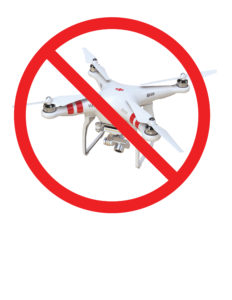
Recently, five new anti-drone products have emerged and are creating some unfriendly skies for unauthorized drones.
Drone Dome
An Israeli tech firm wants to create a virtual dome to keep out drones. Rafael Advanced Defense Systems offers Drone Dome – a system billed as a “new end-to-end defense solution designed to detect, identify, track, and neutralize drones.” Drone Dome is essentially a radar/radio jamming system providing defense for strategic targets in a radius of up to 3 km. The system can jam the signal of large drones on down to micro/nano drones, which the company says can be used by terrorists. Under the hood, Drone Dome sports a RPS-42 radar, MEOS electro-optical observation mechanism, and a C-Guard RD wide spectrum signal jammer.
DroneShield
DroneShield uses acoustic technology to detect incoming drones from up to 150 yards and sends e-mails or text messages to a monitoring service. Formerly based in Herndon, Va., the start-up was recently acquired by an Australian venture-capital group. Prisons have started using the product to stop drones from delivering contraband such as cell phones of drugs to prisoners. DroneShield proved that it could also operate in a noisier, less stable environment when it deployed detectors at the2015 and 2016 Boston Marathon. The entire marathon route had been declared a “no-drone zone” by city officials.
AUDS/Pathfinder
The FAA recently partnered with the Anti-UAV Defense System (AUDS) – a team of British anti-drone companies that includes Blighter Surveillance Systems, Chess Dynamics and Enterprise Control Systems. AUDs will join with American company Liteye Systems as “the world’s first fully integrated detect-track-disrupt-defeat” drone defense system. The partnership is one piece of the FAA’s Pathfinder Initiative which is designed, the agency says, to address three areas of national drone integration – “visual line-of-sight operations in urban areas, extended visual line-of-sight operations in rural areas [and] beyond visual line-of-sight in rural/isolated areas.”
Cyber-Rifle
A visit to West Point by the U.S. Secretary of Defense is not a rare occurrence. However, watching the nation’s top defense official zap a drone with a state-of-the-art, anti-drone rifle is not an everyday event.
But that’s the scene that greeted cadets and dignitaries in March as Secretary Ashton Carter took out a Parrot quadcopter with the U.S. Army’s newest innovation – a drone-killing rifle that can be built for about $150 in parts. Soldiers first unveiled the aptly named “cyber-rifle” in October — a weapon that resembles a standard, Army-issue M4/16 rifle. Designed by the Army Cyber Institute, the rifle emits a radio signal that can command a UAV to power down – resulting in the inevitable plummet to terra firma. Following the rifle’s successful test, the Defense Department posted a video of the demo to its Twitter account.
SkyWall
A British engineering firm’s new anti-drone system is practically ripped from the pages of a James Bond script. In March, OpenWorks Engineering demonstrated SkyWall (a truly Bond-esque name) at a UK Home Office security conference. According to an OpenWorks press release, the solution is a simple concept — it “physically captures a drone in a net and brings it to the ground safely under a parachute.” The device resembles a missile launcher and can deploy an “intelligent projectile with on-board countermeasures” up to 100 meters. After the launcher’s targeting AI calculates a drone’s trajectory, the launched projectile hunts down the errant drone, apprehending it with an on-board net/parachute apparatus.
Jason is a longstanding contributor to DroneLife with an avid interest in all things tech. He focuses on anti-drone technologies and the public safety sector; police, fire, and search and rescue.
Beginning his career as a journalist in 1996, Jason has since written and edited thousands of engaging news articles, blog posts, press releases and online content.
Email Jason
TWITTER:@JasonPReagan
Subscribe to DroneLife here.